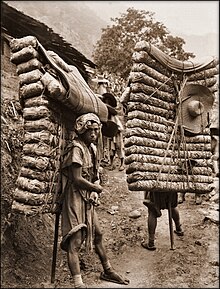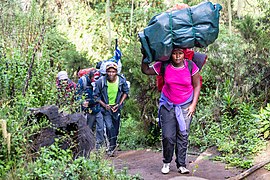
K2, at 8,611 metres (28,251 ft) above sea level, is the second-highest mountain on Earth, after Mount Everest at 8,849 metres (29,032 ft). It lies in the Karakoram range, partially in the Gilgit-Baltistan region of Pakistan-administered Kashmir and partially in the China-administered Trans-Karakoram Tract in the Taxkorgan Tajik Autonomous County of Xinjiang.

Mountaineering, mountain climbing, or alpinism is a set of outdoor activities that involves ascending mountains. Mountaineering-related activities include traditional outdoor climbing, skiing, and traversing via ferratas that have become sports in their own right. Indoor climbing, sport climbing, and bouldering are also considered variants of mountaineering by some, but are part of a wide group of mountain sports.

Ang Rita Sherpa was a Nepali mountaineer who climbed Mount Everest ten times without using supplemental oxygen between 1983 and 1996. His sixth climb set the world record for the most successful ascents of Mount Everest, which he re-set on his tenth climb. Although others have since summitted Everest more, he still holds the record for most summits without supplemental oxygen. He was also the first, and to date only, person to climb Mount Everest without supplemental oxygen in winter. He was nicknamed the "Snow Leopard" by his peers.

Lino Lacedelli was an Italian mountaineer. Together with Achille Compagnoni, on 31 July 1954 he was the first man to reach the summit of K2.

Walter Bonatti was an Italian mountaineer, alpinist, explorer and journalist. He was noted for many climbing achievements, including a solo climb of a new alpine climbing route on the south-west pillar of the Aiguille du Dru in August 1955, the first ascent of Gasherbrum IV in 1958, and, in 1965, the first solo climb in winter of the North face of the Matterhorn on the mountain's centenary year of its first ascent. Immediately after his solo climb on the Matterhorn, Bonatti announced his retirement from professional climbing at the age of 35, and after 17 years of climbing activity. He authored many mountaineering books and spent the remainder of his career travelling off the beaten track as a reporter for the Italian magazine Epoca. He died on 13 September 2011 of pancreatic cancer in Rome aged 81, and was survived by his life partner, the actress Rossana Podestà.
Alan Paul Rouse was the first British climber to reach the summit of the second highest mountain in the world, K2, but died on the descent.

David Sharp was an English mountaineer who died near the summit of Mount Everest. His death caused controversy and debate because he was passed by a number of other climbers heading to and returning from the summit as he was dying, although a number of others tried to help him.
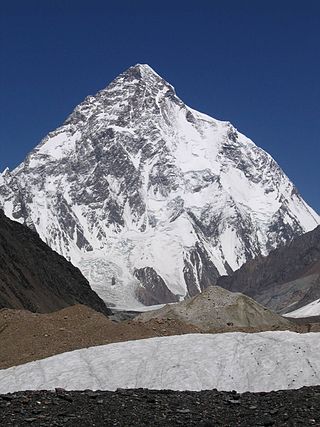
The 1953 American Karakoram expedition was a mountaineering expedition to K2, at 8,611 metres the second highest mountain on Earth. It was the fifth expedition to attempt K2, and the first since the Second World War. Led by Charles Houston, a mainly American team attempted the mountain's South-East Spur in a style which was unusually lightweight for the time. The team reached a high point of 7750 m, but were trapped by a storm in their high camp, where a team member, Art Gilkey, became seriously ill. A desperate retreat down the mountain followed, during which all but one of the climbers were nearly killed in a fall arrested by Pete Schoening, and Gilkey later died in an apparent avalanche. The expedition has been widely praised for the courage shown by the climbers in their attempt to save Gilkey, and for the team spirit and the bonds of friendship it fostered.
Gerard McDonnell, mountaineer and engineer, was the first Irishman to reach the summit of K2, the second-highest mountain on Earth, in August 2008. He died along with 10 other mountaineers following an avalanche on the descent, in the deadliest accident in the history of K2 mountaineering.

Expedition style refers to mountaineering which involves setting up a fixed line of stocked camps on the mountain which can be accessed at one's leisure, as opposed to Alpine style where one carries all of one's food, shelter, equipment etc. as one climbs. Expedition style also incorporates the use of fixed ropes, and climbers will travel up and down the route several times to fix ropes and set up camps, while Alpine style eschews fixed ropes, porters, and camps, and climbers usually only climb the route once in a continuous push. Expedition style was the type of climbing Sir Edmund Hillary and Tenzing Norgay used in the first summitting of Mount Everest.

Amir Mehdi was a Pakistani mountaineer and porter known for being part of the team which managed the first successful ascent of Nanga Parbat in 1953, and of K2 in 1954 with an Italian expedition. He, along with the Italian mountaineer Walter Bonatti, are also known for having survived a night at the highest open bivouac - 8,100 metres (26,600 ft) - on K2 in 1954.

Alpine climbing is a type of mountaineering that involves using any of a broad range of advanced climbing skills, including rock climbing, ice climbing, and/or mixed climbing, to summit typically large routes in an alpine environment. While alpine climbing began in the European Alps, it is used to refer to climbing in any remote mountainous area, including in the Himalayas and in Patagonia. The derived term alpine style refers to the fashion of alpine climbing to be in small lightly-equipped teams who carry all of their own equipment, and do all of the climbing.
Pasang Lhamu Sherpa Akita is a Nepali Sherpa mountaineer. She was the first woman in Nepal to become a mountaineering instructor, was one of the first Nepali women to reach the summit of K2, and has been active in earthquake relief in Nepal. In 2016, she was named National Geographic's People’s Choice Adventurer of the Year, and was presented with the 45th International Alpine Solidarity Award in Pinzolo, Italy.
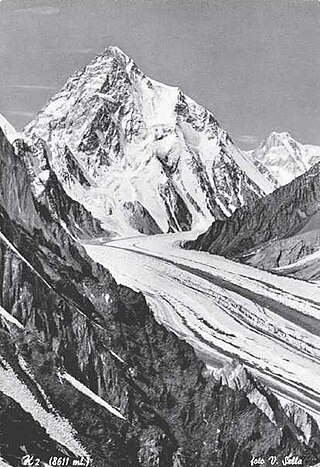
The 1939 American Karakoram expedition to K2 was the unsuccessful second attempt by American mountaineers to climb the then-unclimbed second-highest mountain in the world, K2, following the 1938 reconnaissance expedition. Fritz Wiessner, the leader of the expedition, and Pasang Dawa Lama got to within 800 feet (240 m) of the summit via the Abruzzi Ridge – a difficult and arduous route – with Wiessner doing practically all the lead climbing. Through a series of mishaps, one of the team members, Dudley Wolfe, was left stranded near the top of the mountain after his companions had descended to base camp. Three attempts were made to rescue Wolfe. On the second attempt three Sherpas reached him after he had been alone for a week at over 24,000 feet (7,300 m) but he refused to try to descend. Two days later the Sherpas again tried to rescue him, but they were never seen again. A final rescue effort was abandoned when all hope for the four climbers had been lost.

On 31 July 1954 Achille Compagnoni and Lino Lacedelli reached the summit of K2, 8,611 metres (28,251 ft), for the first time on the 1954 Italian expedition to K2 but for over fifty years the 1954 Italian Karakoram expedition controversy dragged on concerning whether the official report written by the expedition's leader, Ardito Desio, gave a true picture of the expedition. That the climbers did indeed reach the summit was never in dispute.

On the 1954 Italian expedition to K2 Achille Compagnoni and Lino Lacedelli became the first people to reach the summit of K2, 8,611 metres (28,251 ft), the second highest mountain in the world. They reached the summit on 31 July 1954. K2 is more difficult to climb than Mount Everest, 8,849 metres (29,032 ft), which had first been climbed by a British expedition in 1953.

The 1938 American Karakoram expedition to K2, more properly called the "First American Karakoram expedition", investigated several routes for reaching the summit of K2, an unclimbed mountain at 28,251 feet (8,611 m) the second highest mountain in the world. Charlie Houston was the leader of what was a small and happily united climbing party. After deciding the Abruzzi Ridge was most favorable, they made good progress up to the head of the ridge at 24,700 feet (7,500 m) on July 19, 1938. However, by then their supply lines were very extended, they were short of food and the monsoon seemed imminent. It was decided that Houston and Paul Petzoldt would make the last push to get as close to the summit as they could and then rejoin the rest of the party in descent. On July 21 the pair reached about 26,000 feet (7,900 m). In favorable weather, they were able to identify a suitable site for a higher camp and a clear route to the summit.
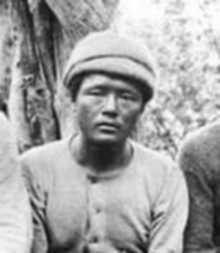
Pasang Kikuli (1911–1939) was a Nepalese mountain climber and explorer who acted as sherpa and later sirdar for many Himalayan expeditions. He died on the 1939 American Karakoram expedition to K2, attempting to rescue a stranded climber.

Nirmal Purja is a Nepal-born naturalised British mountaineer. Prior to taking on a career in mountaineering, he served in the British Army with the Brigade of Gurkhas followed by the Special Boat Service (SBS), the special forces unit of the Royal Navy. Purja is notable for having climbed all 14 eight-thousanders in a time of six months and six days with the aid of bottled oxygen. This was a record at the time of climbing, although it was broken in 2023 by Kristin Harila and Tenjen Sherpa, who summitted all 14 eight-thousanders in 92 days. Purja still is the first to reach the summits of Mount Everest, Lhotse and Makalu within 48 hours. In 2021, Purja, along with a team of nine other Nepalese mountaineers, completed the first winter ascent of K2.
